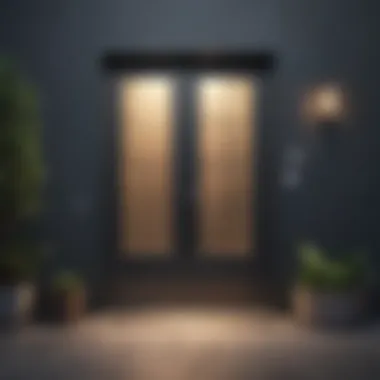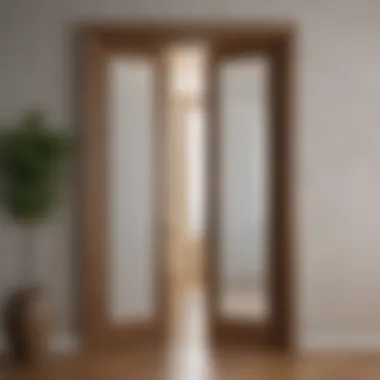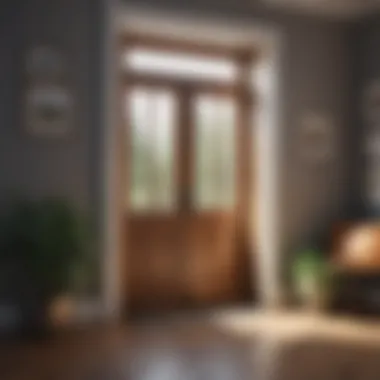Analyzing Costs of New Door Frames: A Homeowner's Guide


Intro
When homeowners decide to enhance their living spaces, new door frames often become a significant consideration. Understanding the cost associated with these frames can be complex, as various factors come into play. The type of material chosen, the design of the frame, and installation expenses can all contribute to the overall cost. Whether one is renovating a current space or constructing a new home, knowing the intricacies of door frame expenses is essential for budget management and project planning.
This article will explore elements such as materials, styles, and practical insights into budgeting for new door frames, providing a roadmap for a successful home renovation.
Design Inspirations
Door frames are not just structural elements; they can greatly influence the aesthetic appeal of a home. When selecting a door frame, it is worthwhile to consider modern trends and how they can harmonize with existing interior themes.
Trending Styles
Different styles resonate with various tastes. Here are some popular options:
- Traditional Style: Often characterized by intricate details and classic shapes, these frames tend to complement period homes beautifully.
- Contemporary Frames: Simple lines and minimalistic design define this style, making it suitable for modern interiors.
- Rustic Frames: Made from wood or reclaimed materials, rustic doors offer a charm that appeals to many homeowners.
- Industrial Frames: Using metals and raw finishes, these frames align with urban aesthetics, providing a striking contrast to softer elements of decor.
Choosing the right style involves ensuring a cohesive look throughout your home. Therefore, understanding the surrounding decor is essential.
Color Palettes
The color of the door frame also plays a crucial role in setting the tone for the space. Homeowners have a spectrum of choices:
- Neutral Colors: Whites, greys, and tans allow other colors in the room to pop.
- Bold Colors: Bright shades such as red or blue can serve as focal points, inviting attention.
- Natural Finishes: Stains that highlight the natural grain of wood can add warmth to interiors.
Rest assured, selecting colors must harmonize with overall room decor and personal preferences.
Maintenance and Upkeep
Once the right door frames are installed, regular maintenance is essential to prolong their lifespan and appearance.
Seasonal Maintenance Checklist
Regular check-ups ensure the longevity of door frames. Here are key tasks to consider:
- Winter: Inspect for drafts and seal any gaps to improve energy efficiency.
- Spring: Clean the frames and inspect for any damage resulting from winter conditions.
- Summer: Check hinges and handles for rust or wear.
- Fall: Apply weather stripping as needed and ensure appropriate sealing.
Cleaning and Organization Tips
A clutter-free space enhances the overall impression of door frames. Keep your frames clean by:
- Using gentle cleaning solutions that do not damage the finish.
- Avoiding abrasive materials that could scratch the surface.
"Investing in quality door frames not only enhances the aesthetic but also ensures durability and functionality for years to come."
With focused consideration and engaged planning, the process of selecting and installing new door frames can transform the essence of a home.
Preamble to Door Frames
The significance of door frames cannot be overstated when it comes to home construction and renovation. They serve as a structural necessity, but they do much more than simply hold doors in place. Rather, they contribute to the overall aesthetics and functionality of a space. This section will explore the definition of door frames, the various materials available, and their applications in both residential and commercial settings.
Definition and Importance
A door frame is the structure that surrounds a door, providing it with support and stability. It consists of vertical elements known as jambs and a horizontal piece at the top known as the head. The door frame is crucial because it creates an opening for the door to fit, ensuring the door operates effectively as it swings open and closed. Additionally, it plays a role in insulation and soundproofing. Selecting the right door frame can enhance the security of a doorway, ultimately impacting the safety of those within the premises.
Overview of Common Materials
Door frames come in a variety of materials, each with unique benefits and drawbacks.
Wood
Wooden door frames are popular due to their aesthetic appeal. They can be painted or stained to match interior design styles. One key characteristic is their natural insulation properties, helping to maintain temperature. However, they are subject to warping and damage from moisture, which can disadvantage them in certain climates.


Metal
Metal frames, often made of steel or aluminum, offer a different set of benefits. Their primary strengths are durability and security. Metal frames are resistant to insects, rot, and warping. Additionally, they are easier to maintain than their wooden counterparts. However, they may lack the warmth and character that wood provides, which can be a consideration for many homeowners.
Composite
Composite materials, which often combine wood fibers with synthetic materials, present a modern alternative. One advantage of composite frames is their resistance to moisture and insects, making them versatile in various environments. These frames also tend to be less expensive than solid wood. On the downside, the appearance may not appeal to those looking for traditional wood aesthetics.
Usage and Applications
The applications of door frames vary significantly between residential and commercial uses.
Residential
In residential settings, door frames are essential as they enhance both the design and functionality of the home. Homeowners often choose frames that compliment their interior. Effective insulation and security features are a priority for many when selecting door frames for their living spaces.
Commercial
Commercial applications of door frames tend to focus on durability and compliance with safety regulations. In these settings, frames must often support heavier doors and withstand higher traffic volumes. Metal frames are more common here due to their resilience and robustness, fulfilling the requirements necessary for commercial use.
"Choosing the right material for your door frames can significantly affect both cost and performance."
In summary, understanding the different types of door frames helps in making informed decisions. The choice of material significantly impacts the durability, aesthetic appeal, and cost associated with door frames. This foundational knowledge sets the stage for a deeper exploration of the factors influencing door frame costs, which will be covered in subsequent sections.
Factors Influencing Door Frame Cost
Understanding the factors that influence the cost of new door frames is essential for homeowners considering renovation or installation projects. The cost can vary significantly depending on several elements such as materials, size, design, and labor. By comprehending these aspects, buyers can make informed choices that meet their budgets and design needs. This segment breaks down these critical factors to provide clarity and insight into door frame cost considerations.
Material Costs
Price Variation by Material
Material costs represent a significant portion of the overall expenses associated with door frame installation. Various materials, such as wood, metal, and composite, have different price points. For instance, wood tends to be more expensive due to its natural aesthetics and durability. Likewise, metal is known for its strength but can also be costlier depending on the alloy used. Composite materials often offer a more budget-friendly option without sacrificing some level of durability. The key characteristic here is that each material brings unique advantages and disadvantages, which can affect the budget significantly. Understanding these price variations helps homeowners make choices aligned with their financial plans and desired characteristics.
Impact of Sustainability
Sustainability is a growing concern in many construction and renovation projects, and door frames are no exception. Eco-friendly materials, like bamboo or recycled wood, tend to be more expensive but can lead to long-term savings and environmental benefits. The key characteristic of sustainable materials is that they minimize environmental impact and often come with better energy efficiency. This makes sustainability an increasingly popular choice. However, the unique feature is that while the initial cost might be higher, the benefits over time, such as lower energy bills and a reduced carbon footprint, can be significant.
Size and Dimensions
Standard Sizes vs. Custom Sizes
Choosing between standard and custom sizes can drastically affect the door frame cost. Standard sizes are generally more affordable and widely available; thus, they may simplify the installation process. In contrast, custom sizes tend to raise costs due to additional material requirements and the need for specialized labor. The key characteristic of standard sizes is accessibility, which often translates to lower prices, making them a beneficial choice for most home projects. However, if a specific aesthetic or architectural requirement exists, custom sizes must be considered, despite the higher cost.
Implications of Framing Thickness
The thickness of the door frame also plays a crucial role in the overall cost. Thicker frames tend to enhance durability and sound insulation, which can be appealing in many settings. The key characteristic of thicker framing is its potential to improve energy efficiency and stability. Hence, while thicker frames may cost more during initial installation, their long-term value and benefits can outweigh the cost, making this a significant consideration in budget planning.
Design Complexity
Simple vs. Ornate Designs
The complexity of a door frame's design can heavily impact its overall cost. Simple designs are often less expensive due to lower material usage and less intricate installation requirements. On the other hand, ornate designs typically involve higher costs due to additional features and material specifications. A key characteristic of simple designs is their versatility and ease of installation, often making them a wise financial choice. However, ornate designs may provide aesthetic appeal that can justify the higher investment, depending on the homeowner's preferences.
Cost of Customized Features
Customized features often lead to increased expenses. Adding elements such as unique finishes, decorative moldings, or specific hardware can elevate the price. The unique feature here is that while these customizations can enhance the overall look and functionality of the door frame, they also require careful consideration of the budget. A significant aspect is balancing the desire for customized aesthetics with the financial implications, as these costs can add up quickly.
Labor and Installation
DIY Installation


Opting for DIY installation can be a practical way to save money but requires knowledge and skill. While it may lower costs associated with labor, it also demands time and effort to ensure proper installation. The key characteristic of DIY installation is that it can reduce expenses but involves risks if not done correctly. Additionally, beginners may face difficulties that could lead to mistakes, potentially increasing overall costs in the long run.
Hiring Professionals
Hiring professionals for installation can ensure timely and quality work, but it can also add substantially to the overall cost. Professionals bring expertise that can prevent installation issues that might arise from DIY approaches. A significant feature is that while this option tends to be pricier, it can provide peace of mind and warranty options that DIY does not typically offer. Therefore, it is critical to weigh the benefits of professional installation against the cost.
Cost of Additional Services
Often, other services may be required during the door frame installation process, such as removals of old frames, finishes, or adjustments to openings. These additional services can incur extra costs that homeowners may not originally budget for. The key characteristic of these extra services is that they might enhance the overall project quality but should be factored into any budgeting considerations. It is essential to plan ahead for these potential additional costs to avoid surprises during the renovation process.
Typical Price Ranges for Door Frames
Understanding the price ranges for door frames is crucial for anyone planning a renovation or new construction. This section aims to provide clear insights into various price points, helping homeowners make informed decisions. Knowledge of typical costs associated with different materials and installation methods empowers individuals to budget accurately and avoid overspending. Identifying cost ranges early in the project can also assist in setting realistic expectations for quality and durability.
Cost Breakdown by Material
Wood Frame Costs
Wood door frames remain a highly favorable option for many homeowners. Their cost typically ranges from $150 to $600, depending on the type of wood and design complexity. One key characteristic of wood frames is their aesthetic appeal. They can seamlessly blend into various interior designs, offering a classic and warm touch.
The unique feature of wood frames is their ability to be customized easily. Homeowners can choose from a variety of finishes, stains, and styles. However, it's important to consider the disadvantages, such as susceptibility to moisture and pests. Consequently, regular maintenance is essential to preserve their durability.
Metal Frame Costs
Metal door frames, usually made from steel or aluminum, are recognized for their strength and durability. The costs for metal frames range from $200 to $700. They are particularly popular in commercial applications due to their security features.
One significant highlight of metal frames is their resistance to weather conditions, which makes them an ideal choice for exterior applications. However, they may not suit every aesthetic preference, as they often present a more industrial look. The unique aspect of metal frames is their longevity, yet their heavy weight can complicate installation.
Composite Frame Costs
Composite door frames have been gaining popularity in recent years, with costs ranging between $180 and $600. These frames are made from a blend of materials, offering both affordability and durability. A key characteristic is their resistance to warping, cracking, and rotting, making them a reliable choice for various environments.
The noteworthy benefit of composite frames is their lower maintenance requirements compared to wood. However, they may not provide the same warm aesthetics as solid wood. Thus, when selecting a composite frame, individuals may need to balance durability with design preferences.
Regional Price Variability
Urban vs. Rural
The location significantly affects the pricing of door frames. Urban areas often see higher costs due to increased demand for materials and labor. Prices can range from $300 to $900 in cities, where the labor market is also competitive.
Conversely, rural areas generally offer more competitive pricing. The costs can be 10% to 30% lower than in urban settings. Nonetheless, homeowners in rural regions might have fewer options for suppliers, which can restrict choices for specific styles and materials.
Seasonal Trends in Pricing
Peak Seasons for Renovation
Typically, costs for door frames reach their peak during the spring and summer months. This is when homeowners seek to complete renovations before enjoying their living spaces in warmer weather. During peak seasons, material prices can increase by 15% due to heightened demand from contractors and homeowners alike.
It is recommended to plan purchases during these months carefully. Those looking to save should consider alternative schedules for their renovation projects, possibly gearing towards the off-peak times.
Off-Peak Discounts
Off-peak seasons, primarily in the fall and winter months, are excellent opportunities to find discounts on door frames. Many suppliers offer incentives or sales as demand dwindles. Discounts can reach up to 20% during these periods, providing significant savings for budget-conscious homeowners.
Utilizing off-peak discounts is an effective financial strategy. Homeowners can take advantage of lower prices while still achieving their desired aesthetic and structural requirements.
Comparing Door Frame Costs with Related Projects
When considering a home renovation, understanding the costs associated with new door frames is essential. A vital part of this understanding comes from comparing door frame costs with related projects, such as installing new doors or replacing old frames. This comparison helps homeowners to assess their overall budget effectively and prioritize their renovation efforts.
Installing New Doors


Installing new doors often goes hand-in-hand with new door frames. The cost of this project can vary widely based on the type of door selected — wooden doors may carry different expenses compared to metal or composite alternatives. Homeowners should consider the following factors:
- Door Material: The material chosen for the door will impact both the purchase and installation costs. Wooden doors, for example, may be more expensive but provide a classic look. In contrast, metal doors could provide added security at a lower upfront cost.
- Size and Customization: Standard door sizes are often less expensive than custom options. If a homeowner desires a unique look, they might incur additional costs for custom-made doors and frames.
- Labor Costs: Installation labor can add significantly to the overall expense. It is advisable to get quotes from various professionals to find a fair price, while also evaluating whether some might choose to DIY this stage to save money.
Replacing Old Frames
Replacing old frames can be a necessary step for many renovation projects. Older frames may have suffered wear and tear, affecting the overall appearance and function of the doors they hold. Here are some key points to keep in mind:
- Condition of Old Frames: The more deteriorated the old frames are, the higher the cost may be for removal and replacement. If significant repairs are needed, that contributes additional expenses.
- Matching Styles: Homeowners who aim to match existing architectural styles may face additional costs. Custom frames to match old styles tend to require more resources and skilled craftsmanship.
- Energy Efficiency: New frames can help improve insulation, and thus can lead to long-term savings on energy bills. While the initial cost may seem high, the efficiency benefits may justify the investment.
Budgeting for a New Door Frame
Budgeting for a new door frame is crucial for homeowners. Proper budgeting ensures that a renovation project remains financially feasible and that all related costs are considered. Understanding how to budget accurately helps avoid surprises down the line, leading to better decision-making concerning materials, labor, and design choices. Moreover, it ultimately makes the entire renovation process smoother.
Establishing a Realistic Budget
Estimating Total Costs
Estimating total costs is the foundation of a successful budget for a new door frame. This involves calculating the expense of materials, labor, and any additional accessories. The primary emphasis should be on the material selection, since some materials, like solid wood or high-quality metal, can be significantly more expensive than alternatives. Being realistic about costs prevents overspending and allows for appropriate choices that align with financial capabilities.
A key characteristic of estimating total costs involves an overview of expenses rather than just focusing on initial material prices. It is beneficial because it encompasses labor and installation fees. It helps homeowners to set an appropriate budget limit.
However, specific costs may vary significantly across different regions. Homeowners should consider obtaining multiple quotes from suppliers and contractors, thus allowing for a more accurate estimate of total expenses. A unique feature of this process is accounting for future maintenance costs associated with different materials, which can affect overall spending.
Identifying Hidden Costs
Identifying hidden costs is another vital component of budgeting for a door frame. These hidden costs include fees such as permits, disposal of old frames, and sometimes unexpected expenses due to structural issues discovered during installation. Being aware of these potential additional costs can help prevent budget overruns.
The primary highlight here is that identifying hidden costs makes budgeting more thorough. It ensures the homeowner takes into account all relevant factors impacting the total cost. Not only does this create a more realistic budget, but it encourages homeowners to investigate further before finalizing decisions.
The unique feature of identifying hidden costs lies in its preventive nature. Not facing these challenges until installation can lead to panic and rushed decisions. Approaching budgeting with a sense of foresight can save both money and time.
Financial Options for Home Projects
Financial options for home projects provide additional avenues for homeowners looking to budget effectively. Exploring these tools can enhance the financial flexibility needed for a successful renovation.
DIY Financing
DIY financing refers to the approach of using personal savings to fund a home project. This strategy can be effective since it avoids the costs associated with loans or credit. Additionally, it encourages careful planning and prioritization based on available funds. The key characteristic of DIY financing is its simplicity, which is appealing to many homeowners due to lower overall costs.
However, the unique feature of relying on personal savings can sometimes restrict project scope, especially if funds are limited. It may lead to delays, as building up savings might take longer than desired. An important balance should be found between ambition and financial reality to ensure that the project progresses sensibly.
Utilizing Credit Wisely
Utilizing credit wisely can support homeowners undertaking a door frame project without depleting savings. This approach allows for immediate access to funds and the potential for completing projects sooner. The key characteristic of using credit wisely lies in managing repayment plans to avoid long-term debt. This means understanding interest rates and terms thoroughly before proceeding.
A unique feature of this financial approach is its impact on credit scores. Responsible use of credit can build a strong financial history. However, if not managed properly, it could lead to severe financial stress as interest accumulates. Homeowners should approach this option with caution and ensure they are well-informed about their repayment capabilities.
"Effective budgeting is not just about limiting expenses; it's about creating a realistic plan that accommodates all aspects of a project."
In summary, budgeting for a new door frame plays an essential role in ensuring renovations are successful and sustainable. By establishing a realistic budget and being aware of financial options, homeowners can make informed decisions that align with their goals.
End
Recap of Cost Considerations
In summation, various elements significantly influence the overall cost of door frames. Here are key takeaways:
- Materials: The choice between wood, metal, or composite impacts pricing. Each material carries unique advantages and drawbacks affecting durability and maintenance costs.
- Size and Customization: Standard sizes may be less expensive, but custom options provide a tailored approach to aesthetic appeal.
- Design Complexity: Simple designs generally cost less compared to intricate ones. Homeowners must weigh the aesthetic appeal against potential costs.
- Labor Charges: Deciding between DIY or professional installation can lead to stark differences in total expenses.
Understanding these factors aids in navigating budget planning effectively and identifying potential hidden costs that may arise during the project.
Final Thoughts
In closing, approaching the renovation of door frames with a clear budget and understanding of costs is essential for homeowners. Prioritize selecting frames that not only fit within financial parameters but also serve functional and design purposes. Remaining informed about current trends and options allows for better decisions about door frames.
Considering these insights ensures that when you begin the project, there is clarity and preparedness, which ultimately makes the renovation experience more rewarding. Embracing both the aesthetic and functional elements of door frames will elevate an overall interior environment, making it worthwhile in the long run.







